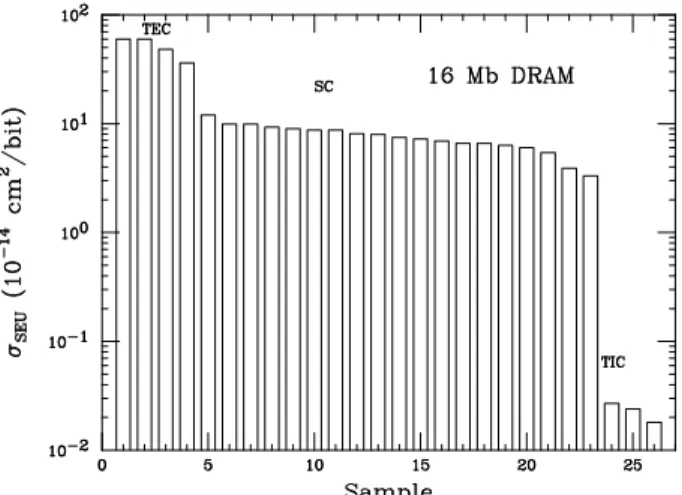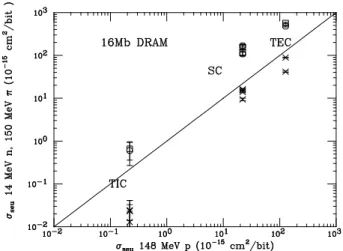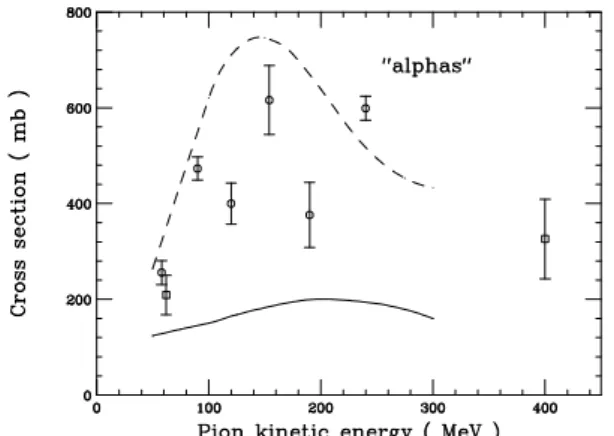246 Brazilian Journal of Physics, vol. 33, no. 2, June, 2003
Radiation-induced Errors in Memory Chips
R. J. Peterson
University of Colorado, Boulder, CO 80309-0446 USA
Received on 30 October, 2002
We have measured probabilities for proton, neutron and pion beams from accelerators to induce temporary or soft errors in a wide range of modern 16 Mb and 64 Mb DRAM memory chips, typical of those used in aircraft electronics. Relations among the cross sections for these particles are deduced. Measurement of alpha particle yields from pions on aluminum, as a surrogate for silicon, indicate that these reaction products are the proximate cause of the charge deposition resulting in errors.
I
Introduction
In 1978 a serious industrial problem was causing errors in the memory contents of Intel 2107 16Kb DRAM (Dynamic Random Access Memory) chips.[1] These temporary or soft errors did not damage the chip, but an erroneous ‘zero’ had replaced a ‘one’, or vice versa, spoiling the contents of the memory. This problem was traced to small amounts of alpha-emitting impurities in the materials. These 5 MeV al-pha particles caused ionization in the Si of the chip, and the collected charge was enough to redefine the memory state.
Later, in repair records from 1984, IBM found a corre-lation between these errors, here called ’soft error upsets’ or SEU, and altitude. These errors were then shown to be closely correlated with cosmic ray intensities.[2, 3] In Den-ver, at 1700m, the SEU rate was ten times the national aver-age.
It is easy to understand how heavily-ionizing low en-ergy alpha particles, with a range of 25 microns in Si, could deposit disruptive charge, but how would high energy neu-trons, protons and pions from cosmic ray reactions induce errors? At sea level, most cosmic rays are muons, with only small cross sections for any reactions, but evidently en-ergetic hadrons can cause reactions within microcircuits to produce short range heavily ionizing reaction products.
A series of experiments with intense accelerator beams has been used to measure the probabilities or cross sections for hadrons to induce SEU in a wide range of modern mem-ory chips. These measurements are particularly important for commercial and military aircraft, with their high altitude operations.
Here we define
σSEU =
induced errors
number of sample bits × particles/cm2.
II
Accelerator testing
Commercially available memory chips were placed directly in our beams. Proton beams were mostly from the Harvard cyclotron, at energies from 50 to 150 MeV.[4] Pion beams from LAMPF [5] and TRIUMF [6] and a 14 MeV neutron generator [7] have been used. Appropriate beam monitoring gave beam fluxes, for instance 0.1 - 1×106pions/cm2sec. A special driver box alternately wrote and read patterns of zeros and ones into the memory chips. Discrepancies were counted as errors. The 16 Mb samples used three tech-nologies - Trench External Charge (TEC), Stacked Capac-itor (SC) and Trench Internal Charge (TIC). Samples from several manufacturers were chosen for TEC and SC tech-nologies.
For 16 Mb TEC samples the pion cross sections showed clear evidence, in the macroscopic chip, of the familiar 3-3 pion-nucleon resonance.[5] See Fig. 1. We also note the expected charge symmetry betweenπ+
andπ− beams for
reactions upon symmetric28Si. The curve shows the com-putedπ+
/π− averaged28Si reaction cross section.[8]
Pro-ton SEU cross sections are lower, and show no resonant ef-fect; proton reaction cross sections show no resonances in this high range of energies.[9] A single datum shows the SEU cross section for 14 MeV neutrons. A smaller range of pion energies was used for the 64 Mb DRAM samples, and the 3-3 resonance was not obvious, as seen in Fig. 1.[6]
III
Comparisons
R. J. Peterson 247
Figure 1. Crosses show measured cross sections for proton-induced SEU in 16 Mb and 64 Mb DRAM samples. The 16 Mb sample used the TEC technology. Squares show data forπ−,
cir-cles forπ+
for the same chip. The solid curve shows computed [8]
π+
/π−−averaged reaction cross sections for28Si using the right
hand scale. The pi-nucleon 3-3 resonance is prominent in the 16 Mb macroscopic device. The dashed curve shows proton reaction cross sections.[9] A single datum shows the cross section for 14 MeV neutrons.
Figure 2. Cross sections for SEU for many samples of 16 Mb dRAM chips are compared for 150 MeVπ+
beams. TEC, SC and TIC samples are clearly separated. Examples with the lowest cross sections use the TIC technology.
Figure 3. SEU cross sections for 154 MeVπ+
are shown for a range of 64 Mb samples. The lowest values are for TIC samples.
Only SC and TIC technologies were used for the 64 Mb samples we tested, and again a strong difference is found for cross sections for these technologies. Cross sections for sev-eral samples from sevsev-eral manufacturers are shown in Fig. 3. A similar pion experiment measured SEU in a commer-cial 64 kb SRAM, with results shown in Fig. 4. Largest pion SEU cross sections for 16 Mb and 64 Mb DRAM samples were 6×10−13and 4×10−14cm2, comparable to these
for the SRAM sample.
Figure 4. SEU cross sections in a 64 kb SRAM sample are shown by circles for a range ofπ+
beam energies, and a singleπ−datum
is shown by the cross.
To understand these effects, we need to compare the charge left in Si by ionizing particles to the charge that deter-mines a memory state. The critical charge that distinguishes a ‘0’ from a ‘1’ in a modern device is about 50 fC or about 0.3 million ion pairs. One MeV deposited in Si creates 0.28 million pairs, or 45 fC, very near a critical charge. A mini-mum ionizing particle deposits only about 0.47 keV per mi-cron, or 130 pairs per micron of its passage. Since memory cells are only a few microns on a side, this dE/dx is not the cause of errors. In contrast the 5 MeV alpha particles from natural radioactivity have a range of 25 microns, and deposit hundreds of keV per micron as they slow. If charge is col-lected from different volumes of Si by the several chip types, greater or lesser amounts of charge may be collected.
The set of identical 16 Mb samples used for Fig. 2 was studied by us with the same equipment for 148 MeV pro-tons, 150 MeV pions and 14 MeV neutrons.[4] Pions of this energy sit atop the fundamental 3-3 resonance where reac-tion cross secreac-tions are largest. The scatter plot to compare these is shown in Fig. 5. Note that the resonant energy pions have cross sections larger than for protons or neutrons.
248 Brazilian Journal of Physics, vol. 33, no. 2, June, 2003
Figure 5. SEU cross sections for 16 Mb samples are compared for 150 MeV pi mesons and 148 MeV protons. Circles compare
π+
and protons and squares compareπ−and protons. Crosses
compare SEU cross sections for 14 MeV neutrons to those for 148 MeV protons. The same chip was used for each datum, with TIC technology for the cluster of low cross sections. The line indicates equal cross sections for each beam species.
In both scatter plots the solid line indicates proton cross sections equal to those for the neutrons or the pions. At this resonance energy pion σSEU are about three times larger than proton data. We note the wide range of cross sections, and thus susceptibility to errors in the circuits, with TIC de-vices less sensitive than SC dede-vices. The TEC technology is not used for 64 Mb chips.
One might expectσSEUto be related toσR, the reaction cross section for all that happens other than elastic scatter-ing. TheseσRare known or calculated reliably. PionσSEU for 16 Mb TEC devices show a close proportionality toσR from 50 to 400 MeV, across the important resonance region, as shown in Fig. 1. This ratio is very different for other sam-ples, but the resonance is visible in all samples studied for a range of pion beam energies. The ratio of protonσSEU to
σRincreases only slightly from 60 to 300 MeV.[6]
Figure 6. SEU cross sections for 64 Mb samples are compared for 150 MeV pi mesons and 148 MeV protons. Circles compare
π+
and protons and squares compareπ−and protons. Crosses
compare SEU cross sections for 14 MeV neutrons to those for 148 MeV protons. The same chip was used for each datum, with TIC technology for the cluster of low cross sections. The line indicates equal cross sections for each beam species.
These data show smaller SEU cross sections for 64 Mb samples than for 16 Mb samples. If the chip area is the same, there would be a factor of four difference between the cross-sectional areas per bit for these two densities. Older chips with lower densities have also had soft error cross sec-tions measured for cosmic rays.[10] Fig. 7 shows those SEU cross sections and those currently measured for pions with the largest cross sections. These cross sections drop more quickly than just the cross sectional area, and more like the linear dimension to the third power, as if the sensitive vol-ume is decreasing, not just the cross sectional area.
Figure 7. SEU cross sections per bit have been decreasing with in-creasing bit density. Present pion data for the examples with largest cross sections for 16 Mb and 64 Mb (n=26) are compared to earlier cosmic ray data. [3] The decrease is stronger than expected even by the decreasing square of linear dimensions.
For these typical modern devices, we have thus found empirical connections among data for neutrons, protons and pions. These suffice for modeling responses to cosmic ray fluxes for many current applications. Further, our results in-dicate that we need measureσSEU for only one set of these beams to infer responses to the others. This can lead to a dramatic decrease in the cost of testing.
Experts can model the fluxes of protons, neutrons and pions from cosmic rays at a range of altitudes and latitudes. Together with our data, we can now calculate rates of soft er-rors in complex avionics packages for commercial and mili-tary aircraft, depending on the type and manufacturer of the memory chips used.[11]
IV
Reaction mechanisms
R. J. Peterson 249
dangerous sources of SEU.[1] Reaction model calculations for protons and pions on Si provide spectra for emerging al-pha particles that peak near this energy of 5 MeV [13], but measurements have not gone to such low energies.
We have carried out an early measurement of alpha parti-cles in the 5 MeV energy range emerging from Al, as a sim-ple substitute for Si, using pion beams from TRIUMF and commercial plastic track detector technology. Error bars are large, and experimental control was difficult. Our method was also not able to distinguish between alpha particles and low energy protons which also leave heavy ionization in the material. Our method has no real energy determination, but is expected to be sensitive for alpha particle energies from 0.5 to 6 MeV.
Figure 8. Squares show data forπ−induced yields of alpha
par-ticles from 0.5 to 6 MeV from an Al sample, while circles show
π+
data. These data used plastic track detector technology, with-out the ability to distinguish energies or to preclude events due to low energy protons. The solid curve shows the integrals over computed alpha particle spectra across the range of our expected sensitivity.[14] The dashed curve shows the computed pion reac-tion cross secreac-tions for27
Al.
Nonetheless, we present in Fig. 8 the cross sections we have measured.[14] Comparison is made to an integral over the calculated spectra [13] across the alpha particle energy range we expect to be able to sense, and to the computed reaction cross sections. Yields are large and seem to reflect the 3-3 resonance as expected. The measured cross sections are near the reaction cross sections, indicating a multiplicity
greater than one, possible for the very high excitation en-ergies that can be available from pion absorption. We are thus confident, even from this rough measurement, that pion (and presumably proton and high energy neutron) reactions produce alpha particles within the body of the microcircuits, and these short range and heavily ionizing products deposit the energy and charge needed to induce a transition among ones and zeroes to cause the SEU.
Acknowledgements
This work was supported in part by the USDOE, with the strong collaboration of IBM and the US Naval Academy.
References
[1] T. May and N. Woods,IEEE Trans. Electron Devices26, 2 (1979).
[2] J. F. Ziegler and W. A. Lanford,Science200, 776 (1979). [3] J. F. Ziegler et al.,IBM J. Research and Devel.40, 3 (1996). [4] J. F. Ziegler et al.,IEEE Trans. Solid State Circuits33, 246
(1997).
[5] C. J. Gelderloos et al., IEEE Trans. Nucl . Sci. 44, 2237 (1997).
[6] G. J. Hofman et al.,IEEE Trans. Nucl. Sci.47, 403 (2000). [7] J. D. Shell et al., 1997 HEART/GOMAC Conference, Las
Vegas.
[8] A. A. Ebrahim and R. J. Peterson, Phys. Rev. C54, 2499 (1996); R. J. Peterson,Few Body Sys. Suppl.9, 17 (1995). [9] R. F. Carlson,At. Data Nucl. Data Tables63, 93 (1996). [10] cited in Ref. 3.
[11] M. E. Nelson et al.,Jour. Radiation Effects, Research and Engin.19, 100 (2001).
[12] G. R. Srinivasan,IEEE Trans. Nucl. Sci.41, 2063 (1994). [13] G. Srinavasan, H. Tang and P. Murley,IEEE Trans. Nucl. Sci.


